CCNA – RIP Questions
Here you will find answers to RIP Questions
Note: If you are not sure about RIP, please read my RIP tutorial.
Question 1
Which statement about RIPng is true?
A. RIPng allows for routes with up to 30 hops.
B. RIPng is enabled on each interface separately.
C. RIPng uses broadcasts to exchange routes.
D. There can be only one RIPng process per router.
Answer: B
Explanation
RIPng is similar to RIPv2 but is used for IPv6. But unlike RIPv1 and RIPv2, RIPng is enabled on each interface separately. For example:
Router(config)#ipv6 unicast-routing (Enables the forwarding of IPv6 unicast datagrams globally on the router)
Router(config)#interface fa0/0
Router(config-if)#ipv6 rip 9tut enable (9tut is the process name of this RIPng)
Question 2
What are two characteristics of RIPv2? (Choose two)
A. classful routing protocol
B. variable-length subnet masks
C. broadcast addressing
D. manual route summarization
E. uses SPF algorithm to compute path
Answer: B D
Question 3
Refer to the exhibit. Which (config-router) command will allow the network represented on the interface to be advertised by RIP?
| router rip version 2 no auto summary ! interface ethernet0 ip address 10.12.6.1 255.255.0.0 |
A. redistribute ethernet0
B. network ethernet0
C. redistribute 10.12.0.0
D. network 10.12.0.0
Answer: D
Question 4
Refer to the exhibit. What information can be gathered from the output?
| RouterA#debug ip rip RIP protocol debugging is on00:34:32: RIP: sending v2 flash update to 224.0.0.9 via FastEthernet8/0 (172.16.1.1) 00:34:32: RIP: build flash update entries 00:34:32: 10.10.1.0/24 via 0.0.0.6, metric 1, tag 0 00:34:32: RIP: sending v2 flash update to 224.0.0.9 via Loopback (10.10.1.1) 00:34:32: RIP: build flash update entries 00:34:32: 10.0.0.0/8 via 0.6.0.0, metric 2, tag 0 00:34:32: 172.16.1.0/24 via 0.0.0.0, metric 1, tag 0 00:34:32: RIP: ignored v2 packet from 16.10.1.1 (sourced from one of our addresses) 06:34:33: RIP: received v2 update from 172.16.1.2 on FastEthernet0/6 66:34:33: 16.6.0.0/8 via 6.0.6.6 in 1 hops 66:34:44: RIP: sending v2 update to 224.6.6.9 via FastEthernet0/0 (172.16.1.1) 66:34:44: RIP: build update entries 66:34:44: 10.10.1.0/24 via 0.0.0.0, metric 1, tag 0 |
A. One router is running RIPv1.
B. RIP neighbor is 224.0.0.9.
C. The network contains a loop.
D. Network 10.10.1.0 is reachable.
Answer: D
Question 5
Which series of commands will configure router R1 for LAN-to-LAN communication with router R2? The enterprise network address is 192.1.1.0/24 and the routing protocol in use is RIP. (Choose three)
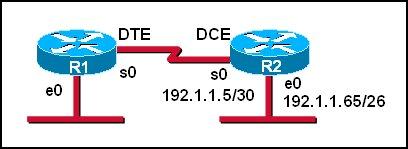
A.
R1 (config)# interface ethernet 0
R1 (config-if)# ip address 192.1.1.129 255.255.255.192
R1 (config-if)# no shutdown
B.
R1 (config)# interface ethernet 0
R1(config-if)#ip address 192.1.1.97 255.255.255.192
R1 (config-if)# no shutdown
C.
R1 (config)# interface serial 0
R1 (config-if)# ip address 192.1.1.4 255.255.255.252
R1 (config-if)# clock rate 56000
D.
R1 (config)# interface serial 0
R1(config-if)#ip address 192.1.1.6 255.255.255.252
R1 (config-it)# no shutdown
E.
R1 (config)# router rip
R1 (config-router)# network 192.1.1.4
R1 (config-router)# network 192.1.1.128
F.
R1 (config)# router rip
R1 (config-router)# version 2
R1 (config-router)# network 192.1.1.0
Answer: A D F
Explanation
First we notice that the ip address of the E0 interface of R2 is 192.1.1.65/26, which has:
+ Increment: 64 (/26 = 1111 1111.1111 1111.1111 1111.1100 0000)
+ Network address: 192.1.1.64
+ Broadcast address: 192.1.1.127
Therefore, the ip address of the E0 interface of R1 cannot belong to this range or the network cannot operate correctly.
In answer A, the ip address of E0 interface of R1 is 192.1.1.129, which does not belong in this range -> A is correct.
In answer B, E0 interface of R1 has the ip address of 192.1.1.97, which belongs in this range -> B is not correct.
The s0 interface of R1 must belong to the same network of s0 interface of R2, which has:
+ Increment: 4 (/30 = 1111 1111.1111 1111.1111 1111.1111 1100)
+ Network address: 192.1.1.4
+ Broadcast address: 192.1.1.7
The ip 192.1.1.5 has been used by s0 of R2 so the only suitable ip address of s0 of R1 is 192.1.1.6 -> C is wrong but D is correct.
Now the last thing we must do is enabling RIP. Because e0 interface of R1 and e0 interface of R2 have the same major network (192.1.1.0/24) so we must use RIP version 2 to support discontiguous network -> F is correct.
For answer E, if we configure 2 networks
R1 (config-router)# network 192.1.1.4
R1 (config-router)# network 192.1.1.128
then these networks will be automatically summarized as 192.1.1.0 network.
Question 6
Refer to the exhibit. Two routers have just been configured by a new technician. All interfaces are up. However, the routers are not sharing their routing tables. What is the problem?

A. Split horizon is preventing Router2 from receiving routing information from Router1.
B. Router1 is configured for RIP version 2, and Router2 is configured for RIP version 1.
C. Router1 has an ACL that is blocking RIP version 2.
D. There is a physical connectivity problem between Router1 and Router2.
E. Router1 is using authentication and Router2 is not.
Answer: B
Explanation
As we can see from the output, Router2 is sending v1 update and ignoring v2 update from neighbor so we can conclude Router2 is running RIPv1. Its neighbor, Router1 (ip address of 192.168.2.1), is running RIPv2.
Notice that router running RIPv2 can “understand” RIPv1 update but router running RIPv1 cannot understand RIPv2 update.
Question 7
What is the default routing update period for RIPv2?
A. 15 seconds
B. 30 Seconds
C. 180 Seconds
D. 240 Seconds
Answer: B
Question 8
Refer to the exhibit. The network manager is evaluating the efficiency of the current network design. RIPv2 is enabled on all Layer 3 devices in the network. What network devices participate in passing traffic from the PC at 10.10.1.7 to File Server at 10.20.1.6 in the order that they will forward traffic from source to destination?
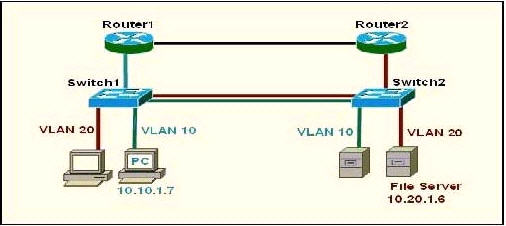
A. Switch, Switch2
B. Switch, Switch2, Router2, Switch2
C. Switch1, Router1, Switch1, Switch2
D. Switch1, Router1, Router2, Switch2
Answer: D
Explanation
The PC and File Server are in different VLANs so surely traffic from PC to File Server must go through Router1 but which path will the packet go next, through Router 2 or Switch1? Well, it is a hard question to answer.
As many comments said “the connection between R1 and Switch is Blue, so that means its under Vlan 10, and R2 to Switch 2 is red. The two routers do not have subinterfaces and are not running router on a stick basing on the color of the links” so D should be the correct answer.
Just for your information, I keep this explanation (which supports answer C) but in the exam you should choose D as your answer!
I haven’t had tested it yet but I guess that because there is a VLAN 20 on Switch 1 so Router1 will try to send that packet back to Switch1. If the link between Switch1 and Switch2 is a trunk link then the returned packet will also be sent to this link. Switch 2 receives that packet and it sends to the File Server at VLAN20. So the path will be Switch1 -> Router1 -> Switch1 -> Switch2.
There are some debates about this question but if the routers are properly configured then the packets can go from Switch1 -> Router1 -> Router2 -> Switch2 (D answer) so D can be a correct answer.
Question 9
Refer to the exhibit. Router A has interfaces with addresses 192.168.1.1 and 172.16.1.1. Router B, which is connected to router A over a serial link, has interfaces with address 172.16.1.2 and 10.1.1.2.
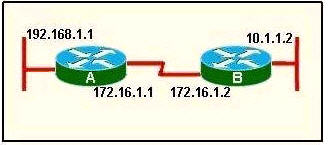
Which sequence of commands will configure RIPv2 on router B?
A.
B( config)# router rip
B(config-router)#version 2
B(config-router)# network 172.16.0.0
B(config-router)# network 10.0.0.0
B(config-router)# end
B.
B(config)# router rip 2
B(config-router)# network 172.16.0.0
B(config-router)# network 10.0.0.0
B(config-router)# end
C.
B(config)# router rip
B(config-router)#version 2
B(config-router)# network 172.16.0.0
B(config-router)#network 192.168.1.0
B(config-router)#end
D.
B(config)# router rip version 2
B(config-router)# network 172.16.0.0
B(config-router)# network 10.0.0.0
B(config-router)#end
Answer: A
Question 10
Refer to the exhibit. S0/0 on R1 is configured as a multipoint interface to communicate with R2 and R3 in this hub-and-spoke Frame Relay topology.
While testing this configuration, a technician notes that pings are successful from hosts on the 172.16.1.0/24 network to hosts on both the 172.16.2.0/25 and 172.16.2.128/25 networks. However, pings between hosts on the 172.16.2.0/25 and 172.16.2.128/25 networks are not successful. What could explain this connectivity problem?
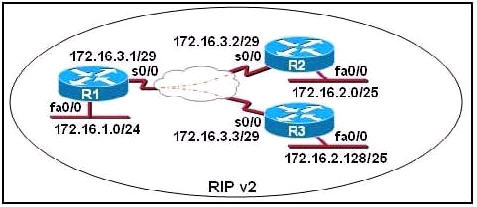
A. The ip subnet-zero command has been issued on the R1 router.
B. The RIP v2 dynamic routing protocol cannot be used across a Frame Relay network.
C. Split horizon is preventing R2 from learning about the R3 networks and R3 from learning about the R2 networks.
D. The 172.16.2.0/25 and 172.16.2.128/25 networks are overlapping networks that can be seen by R1, but not between R2 and R3.
E. The 172.16.3.0/29 network used on the Frame Relay links is creating a discontiguous network between the R2 and R3 router subnetworks.
Answer: C
Explanation
The “ip subnet-zero” allows the use of the first subnet but it doesn’t cause this problem and we don’t have that first subnet (like 172.16.0.0/24) so we can’t confirm if the “ip subnet-zero” was used or not -> A is not correct.
Frame-Relay can use RIPv2 with no problem if we configure it correctly -> B is not correct.
In the exhibit above we notice that the s0/0 interface of R1 has not been divided into sub-interfaces so the split horizon will prevent updates from R2 to R3 and vice versa. The split horizon rule states “A router never sends information about a route back in same direction which is original information came”. In this case R2 send an update to S0/0 of R1 so R1 cannot send that update back on S0/0 -> R3 will not learn about networks of R2 (and vice versa) -> C is correct.
172.16.2.0/25 and 172.16.2.128/25 networks are not overlapping networks. They are two different sub-networks -> D is not correct.
RIPv2 is a classless routing protocol so it supports VLSM and discontiguous networks -> E is not correct.
Question 11
Refer to the exhibit. After a RIP route is marked invalid on Router_1, how much time will elapse before that route is removed from the routing table?
| Router_1# show ip protocols Routing Protocol is “rip” Sending updates every 30 seconds, next due in 8 seconds Invalid after 180 seconds, hold down 180, flushed after 240 Outgoing update filter list foe all interfaces is not set Incoming update filter list for all interfaces is not set Router 1# |
A. 30 seconds
B. 60 seconds
C. 90 seconds
D. 180 seconds
E. 240 seconds
Answer: B
Explanation
The question reads: After a RIP route marked invalid on Router_1, how much time will elasped before that route is removed from the routing table.
The word “REMOVED” in the question means “FLUSHED”
Carefully look at the Router_1 show ip protocol output:
Invalid is 180 secs.
Flushed is 240secs.
RIP route marked invalid (180secs.)
Time elasped before route is removed (Flushed 240secs.)
The difference is 60secs……..240-180=60. Actually is 180+60=240.
Please notice that the invalid timer, hold down timer and flush timer start counting at the same time.
Question 12
Refer to the graphic. Host 1 cannot receive packets from Host 2. Assuming that RIP v1 is the routing protocol in use, what is wrong with the IP configuration information shown? (Choose two)
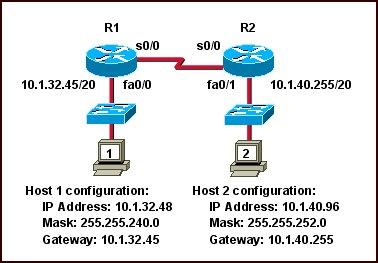
A. The fa0/1 interface of router R2 has been assigned a broadcast address.
B. The fa0/1 network on router R2 overlaps with the LAN attached to R1.
C. Host 2 has been assigned the incorrect subnet mask.
D. Host 1 has been configured with the 255.255.248.0 subnet mask.
E. Host 2 on router R2 is on a different subnet than its gateway.
Answer: B C
Explanation
The fa0/1 interface of R2 is assigned an IP address of 10.1.40.255/20. It seems to be a broadcast address but it is not. If we calculate the range of this network we will understand why:
Network 10.1.40.255/20
Increment: 16 (/20 = 1111 1111.1111 1111.1111 0000.0000 0000)
Network address: 10.1.32.0
Broadcast address: 10.1.47.255
-> 10.1.40.255/20 is an usable host address -> A is not correct.
The IP address of host 1 (10.1.32.48) belongs to the range of interface fa0/1 on R2 as shown above -> B is correct.
In the topology above, all subnet masks are /20 (255.255.240.0) excepting the subnet mask of Host 2 (255.255.252.0) so C can be incorrect.
The subnet mask of Host 1 is 255.255.240.0, not 255.255.248.0 -> D is not correct.
Host 2 is not on a different subnet than its gateway even if the subnet mask 255.255.252.0 is used. Let’s analyze the range of Host 2 network:
Network 10.1.40.96/22
Increment: 4
Network address: 10.1.40.0
Broadcast address: 10.1.43.255
Its gateway (10.1.40.255) is still belongs to this range -> E is not correct.
Note: In this question, C is the best suitable answer after eliminating A, D, E answers. But in fact Host 2 can ping its gateway because they are on the same subnet.
Question 13
What two things will a router do when running a distance vector routing protocol? (Choose two)
A. Send periodic updates regardless of topology changes.
B. Send entire routing table to all routers in the routing domain.
C. Use the shortest-path algorithm to the determine best path.
D. Update the routing table based on updates from their neighbors.
E. Maintain the topology of the entire network in its database.
Answer: A D
Question 14
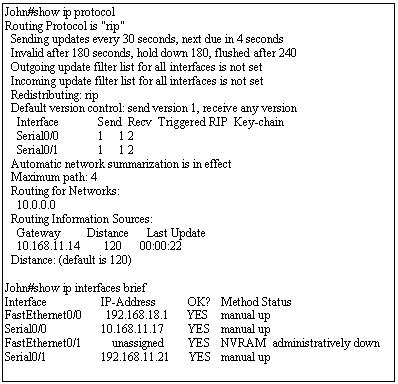
Use the output from the router shown in the graphic above to determine which of the following are correct. (Choose two)
A. Router John uses a link-state routing protocol.
B. Router John will receive routing updates on the Serial0/0 interface.
C. Router John will receive routing updates on the Serial0/1 interface.
D. Router John will send routing updates out the Serial0/0 interface.
E. Router John will send routing updates out the FastEthernet0/0 interface.
F. Router John will send routing updates out the Serial0/1 interface.
Answer: B D
Explanation
As you can see under “Routing for networks”, network “10.0.0.0″ is advertising. The IP address of S0/0 is 10.168.11.17 which belongs to 10.0.0.0 network -> RIP is running on s0/0 interface only, not s0/1 -> S0/0 will send and receive RIP updates.
Question 15
What can be determined from the line of show ip route output shown in the exhibit? (Choose two)
R 10.10.10.8 [120/2] via 10.10.10.6,00:00:25, Serial0/1
A. The next routing update can be expected in 35 seconds.
B. The IP address 10.10.10.6 is configured on S0/1.
C. The IP address 10.10.10.8 is configured on S0/1.
D. This route is using the default administrative distance.
E. The 10.10.10.8 network is two hops away from this router.
Answer: D E
Explanation
From the output, we can see 2 parameters [120/2]. The first is the administrative distance of the routing protocol being used. In this case it is RIP (symbolized by the letter “R”). Because 120 is also the default administrative distance value of RIP -> D is correct.
In RIP, the metric is hop count so “2″ means the network 10.10.10.8 is two hops (routers) away from this router.



What is RIPng? pls explain..
Thanks in adv.
I Got it …
@xallax
Q11
why 60 seconds
explain it plz
@ahmad hamada
it says:
“hold down 180, flushed after 240″
it will be marked as invalid after 180 sec, removed after 240.
how much will pass? 240 – 180 = 60 seconds
Could some explain me 8th question above..
Router John will receive routing updates on the Serial0/0 interface
Router John will send routing updates out the Serial0/0 interface.
@Thuru
I think you meant question 14. You can tell this by the routing for networks section. It states that it is routing for network 10.0.0.0 so by this all interface that fall in the IP range of the 10.0.0.0 255.0.0.0, it is sending v1 so it is classfull and the 10.0.0.0 network is a class A network. This means that only interface Serial0/0 will be the only one participating in the RIP process.
Please someone explain me how we determine those 2 answers(B,D) by the given graphic in Q14?
@DallasNaijan
http://www.examcollection.com/640-802.html
from this site you can download dumps.collisio,jerico,Dharani are the best rated.wish you all the best.
@udana
looking at the default gateway ip address , its at the same subnet as the s0/0, so oly those updates received and sent.
Q1 & Q8 was there in today’s exam. Also it was something similar like Q12
I did not pass my problem was time. I read a Q about 2 to 3 times, just to understand what are talking about it.
@9tut
Can I say the Qs I remember in the test here for others?
@CP: You can but shouldn’t because the questions appear randomly. Others’ exams will surely different from yours!
Question 11
Refer to the exhibit. After a RIP route is marked invalid on Router_1, how much time will elapse before that route is removed from the routing table?
To me the answer is 240 seconds since the invalid and flush timers start at the same time. So as soon as a route is marked as invalid, the flush timer is running too.
Anyone agrees/disagrees
@steph
this question has been debated here on and on. the correct answer is 60 seconds. you’re interested in how much time “After a RIP route is marked invalid”.
it is marked as invalid after 180 sec. it is erased from the routing table after a total of 240 seconds. 240-180 = 60 sec :)
@xallax, I’m aware it’s been debated, but call it a semantic problem, nevertheless the “60 seconds” are the lapse of time after the route has stopped being marked as invalid. Or am I over-analysing the concept ?
Please correct my timeline if I’m wrong :
let start from 00:00
From 00:00 to 03:00 route won’t be updated : hold on timer
From 03:00 to 06:00 route marked as invalid
at 06:30 route is flushed
correction:
at 07:00 route is flushed
@steph
on your example only:
invalid after 6:00, flushed after 6:30
after it was considered invalid, how much time did pass before that route was removed?
6:30-
6:00
——
0:30
answer is 0:30
@xallax Thanks for trying to explain it to me but I don’t see it your way.
It was considered invalid at 3:00 or 3:01 and it remained invalid until 6:00 and then is flushed at 7:00
That’s why to me it’s 7:00 – 3:00 (or3:01) and it gives you 4:00 minutes = 240.
The problem as I see it, is like very often in the formulation of the question: Do we count from the beginning of the invalid lapse(3:00) or from the end (6:00)?
“After a RIP route is marked invalid on Router_1″ means to me as soon as it is marked, but you wait for the end of it to start counting.
I wish Cisco could be clearer sometimes
Once again thank you.
I may have been wrong in my previous posts as far as the order of the timers. I just found this on another website :
“If a router does not receive an update for a RIP route after 180 secs (default invalid timer), the route will be marked as invalid, the route enters the hold-down timer period (180 secs default), the flush timer also begins (240 secs default) and the route is advertised as unreachable in the next sent update. After the hold-down timer’s period ends, there is another 60 secs (flush timer) before the route is completely removed from the routing table.”
If anyone is kind enough to confirm, this is the right order, I will appreciate
Thanks
can someone resolve this for me please
pcA pcb
¦ ¦
switch switch
¦ ¦
router router
¦ ¦
CSU/DSU ————3————-> CSU/DSU
connection< switch–>router–>csu/dsu –>csu/dsu–>router–>switch–>pcb
Question
In the communication between A et B wich technology or witch protocol is represented bs dashed line 1
A-ip
B-T1
c-PPP
d- IEEE 802.3
thanks..
sorry there are dashed lines between pc (1)
between router(2)
between CSU/DSU (4)
@Alpa
Could you explain me, what is RIPng?
Thnx
@nazty
RIPng is IPv6 Routing Protocol (next generation). It is the same as they were with RIPv2 in IPv4. It is still a distance-vector protocol, has a max hop count of 15, and uses split horizon, poison reverse, and other loop avoidance mechanisms, but it now uses UDP port 521. Just read IPv6 & u will get all routing protocols & its details going to be used in IPv6. best of luck.
@Bunty
thanks for description
Could someone explain Q14? I did not get it, I though router John will send updates out from one interface and receive updates from another interface… but in the answer it sends and received from the same interface… Please clarify… thanks!
@jpmarinm, since router is only routing for network “10.0.0.0″ and serial 0 is the only interfac dealing with this network, so router will receive and send updates from serial 0..hope it clarifies..
@jpmarinm
In addition to what @Mark explained to you ( which is totally correct ) I just wanted to add a KEY concept of RIP as routing protocol that might help you understand the answer better
While configuring RIP and you enter the network statement 2 things happen:
1st Not only you are telling RIP what network to advertise
2nd but also telling RIP what interfaces to send advertisements on
According to the exhibit
Routing for networks:
10.0.0.0
That means that is only advertising the 10.0.0.0 network and will only activate the interfaces that belong to that network to send and receive updates, which in this case is only int serial0/0
If you want to be able to advertise 10.0.0.0 out in a different interface like serial0/1 you need to add a new network statement
John(config)#router rip
John(config-router)#network 192.168.11.0
With this you have accomplished 3 things:
1st Now you are advertising the 10.0.0.0 network out on both serial0/0 and serial0/1
2nd Now you have activated the serial0/1 to send and receive updates
3rd Now you are advertising the 192.168.11.0 network on both serial0/0 and serial0/1 as well
If you were to run the show ip protocol command this would be the output now:
—–output omitted—–
Routing for Networks:
10.0.0.0
192.168.11.0
—–output omitted—–
I really hope you find this helpful !!!
i need some explaination for Q.9
interface 192.168.1.0 isn’t mentioned. Is it not needed or is there any other reason
Thanks
@bunty
The Q9 is asking you to configure RIPv2 only on RouterB
RouterB is directly connected ONLY to networks 10.0.0.0 and 172.16.0.0 and there is no point of enter a network statement for 192.168.1.0 since its not directly connected to RouterB.
The 192.168.1.0 network its directly connected ONLY to RouterA, and if you want that address to be advertised, the configuration must be done on RouterA not on RouterB
That’s why is not showing as part of the answer
When we are configuring a Routing Protocol regardless which one we are using ( ospf eigrp rip ) we are telling the router to advertise or share its directly connected networks.
Of course RouterB will eventually advertise not only its directly connected networks but also networks that has learnt from other routers.
I hope you find this helpful !!!
@Danilin
Sorry…..I got it. I thought Question is regarding to Router A.
Thanks for your good clarification
best of luck
in Q3,i believe it should be 10.0.0.0 instead of 10.2.0.0 because while confiiguring RIP(v1 or v2),we need to specify classfull netowk addresses despite the fact that RIPv2 supports VLSM.
I am planning CCNA in April 2nd week…can anyone send me latest dumps to mukesh_crsce@yahoo.in
Q14 –I dont get it — maybe it is too simple — s0/0 — protocol is rip — send v1 receive v1 and 2
and the interface is up — ok??!!
also routing for networks section is network 10.0.0.0
ok?? so is it that we are looking for an interface that is set up to send and receive routing updates???
I think that the way the question is worded is awkward.
thanks danilin on march 28 — your explanation is the best –these comments can be awkward — also — scrolling through a lot of them — I think that the explanation on q14 should be updated –
@Anonymous, you are right, by default RIP summarizes on classful boundaries but there is ” no auto summary” command given in question, also option u suggested is not available in answers :)
plz explain question no 13
A. Send periodic updates regardless of topology changes.
as Distance vector routing protocols such as RIP v2 sends triggered updates too…
RIPv2 has the ability to send triggered updates, but it still periodically sends updates every 30 seconds.
C & F is also correct right, because Serial 1/0 also has send and receive
RIP is a broadcast protocol and it sends routing updates via Serial 0/0 and Serial 1/0
Please clarify
@9tut
Q. 11 refers.
Many dumps including one Jerico.632q take D (240) as the answer. Yours is B. Please explain the descripancies to remove doubts.
@Ngoroko: Please read discussion about Q11 here: http://www.certprepare.com/forum/index.php?showtopic=5629
@9tut
Thanks so much. This is a perfect forum. I believe that its all a matter of different ways in which we interprete the phrasings. Reading and properly understanding the quiz is the best way forward. My stand is 60 sec.
Chao
@9tut, Thanks alot for all the great work and help.. Got CCNA today with 947.. Coming up is CCNP-Switching.
Cheers!!
Q.15 :- Here why the option B is also Not Correct because Network 10.10.10.8 is connected through S0/1 interface with which the next hop address 10.10.10.6 is right……?
Q.15 :- Sorry, i have write the program of rip and run the command #sh ip route and find i am wrong.so a lot of sorry from my side the question is very good…..///
@9tut – Q5 – can you please update your comment “Now the last thing we must do is enabling RIP. Because e0 interface of R1 and e0 interface of R2 have the same major network (192.1.1.0/24) so we must use RIP version 2 to support discontiguous network -> F is correct.”
Whilst the answer “F” is correct, this is NOT a discontiguous network. All subnets are actually from the same classful network – i.e. 192.168.1.x. We use version 2 because we can support VLSM in a CONTIGUOUS network.
If it were discontiguous, R1 and R2 would be separated on say via 192.168.2.x and RIPv2 would (by default) auto sumerise at the classful boundary. This would lead to problems as we would have one part of the 192.168.1.x network on one side, and another part of 192.168.1.x network on the other. To compensate we would have to turn off auto sumerisation and manually sumerise the routes.
Correct answer for Question 11 is:240ms
im writing soon can i please have the latest dumps mokoens@yahoo.com
Thank you @xallax got it.
can i use leadtopass also to prepare?
i need fresh dumps i want to appear in first week of next month i.e May 2012. is there anybody who can help me and send fresh and valid dumps. i will realy be thankful. i have complete prepration but want not to leave a single point of failure. so i need dumps. thanks